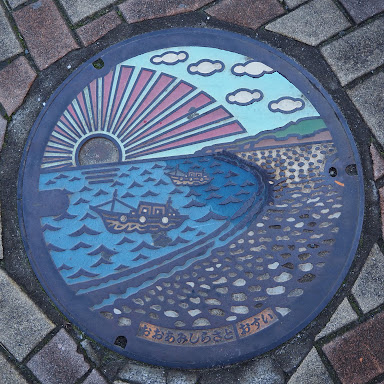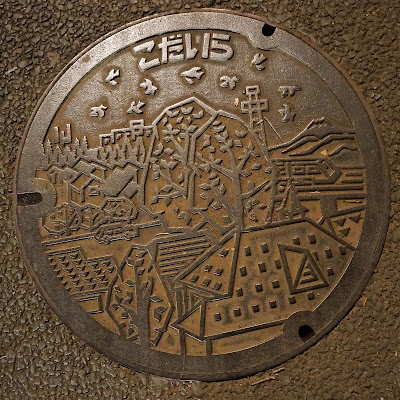Postcard from Japan: Manhole covers - designs of urban art
 |
| A manhole cover with sea, sun and a ship in Oami-Shirasato-city, Chiba prefecture, Japan. |
Japanese love to walk. In Tokyo, sidewalks of the city that is home to 13 million, has a sea of humanity striding to and fro dressed in their impeccable, stylish, traditional and contemporary couture. One cannot help but set one’s sights to the ground and notice tastefully designed metallic circles making a ‘fashion statement’.
On a normal day, these round covers would be best avoided, oft scurried past, with face covered – but then this is Japan, and there are certain things that one doesn’t come across every day.
 |
| A manhole cover in Kodaira City, Tokyo. |
This phenomenon of dotted throughout the country – manhole covers, have over the years, become a tourist attraction in its own right. Don’t be surprised if people are crouching to get the best shot for their memories.
These covers, according to reports, were part of a public-relations campaign in the 1950s with simple geometric patterns. in 1985, Yasutake Kameda, who was civil servant, took these designs to the next level and conceived the artsy designs. These covers have since evolved into integral threads of Japan’s cultural fabric.
The process to make these manhole covers is equally intricate. An aluminium mould is made, which has designs that are selected an approved by the local municipalities. The designs are imprinted on the cover and other covers, which have more intricate designs have coloured resins filled, the process is similar to enamel coating on jewellery.
BOUTIQUE PRICE TAG
Given the complexity of the design and manufacturing process, these covers come with a ‘boutique’ price tag. Typically, a manhole cover, which weighs more than 80 pounds, excluding the frame, costs a little under US$600. In a case where the work involves the addition of resins and colours, which is a labour-intensive process done by hand, the price of the covers can go up to US$900 or more.
 |
| A manhole cover in Kodaira City, Tokyo. |
It is estimated that 95 per cent of Japan’s 1,718 municipalities, across 47 prefectures, boast of their own uniquely designed covers. That is a lot of walking and a lot of covers.
Being a phenomenon, these covers have a fan base and a following – from the Japan Ground Manhole Association, and the ‘fan club’ the Japanese Society of Manhole Covers, which showcases thousands of photographs submitted from across Japan.
It should not be thought that these are merely ornate designs. These manhole covers conform to all standards of safety and usage.
“I should explain that there is more to manhole-cover design than meets the eye,” says Alice Gordenker, who wrote “So, What the Heck is That?” column in the Japan Times. “The most important function of the raised design on manhole covers is not to look good, but to provide traction for the traffic moving over it.
 |
| Manhole covers have become a cultural phenomenon - here one in Yotsuya, Tokyo. |
She says that the designs should also be recognisable no matter which direction they are viewed from, and have lasting appeal, since manhole covers last for decades at least, and often, much longer.
“All in all, there are about 120 million covers in Japan, or one for every woman, child, and man,” Gordenker says.
There is no doubt that when it comes to marrying the left brain with the right, Japan has sort of mastered that art (and science). Art exists in many manifestations, and for a visitor in Japan, ‘looking down’ could spring some very pleasant surprises – and who knows? One might become a part of the manhole fan club.
- Heartfelt gratitude to Floyd Takeuchi for facilitation and coordination of this feature and Moeko Kita, Association for Promotion of International Cooperation (APIC), for the photographs



Comments
Post a Comment